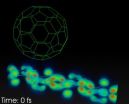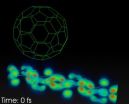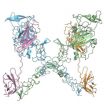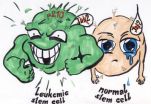(Press-News.org) VIDEO:
Real time quantum simulation of the conversion of light into current in an organic solar cell composed of a polymer chain, and a Fullerene buckyball. The movie lasts for about...
Click here for more information.
Photovoltaic cells directly convert sun light into electricity and hence are key technological devices to meet one of the challenges that mankind has to face in this century: a sustainable and clean production of renewable energy. Organic solar cells, using polymeric materials to capture sun light, have particularly favorable properties. They are low-cost, light-weight and flexible, and their color can be adapted by varying the material composition. Such solar cells typically consist of nanostructured blends of conjugated polymers (long chains of carbon atoms), acting as light absorbers, and fullerenes (nanoscale carbon soccer balls), acting as electron acceptors. The primary and most elementary step in the light-to-current conversion process, the light-induced transfer of an electron from the polymer to the fullerene, occurs at such a staggering speed that it has previously proven difficult to follow it directly.
Now, a team of German and Italian researchers from Oldenburg, Modena and Milano reported the first real time movies of the light-to-current conversion process in an organic solar cell. In a report published in the May 30 issue of Science Magazine, the researchers show that the quantum-mechanical, wavelike nature of electrons and their coupling to the nuclei is of fundamental importance for the charge transfer in an organic photovoltaic device.
"Our initial results were actually very surprising", says Christoph Lienau, a physics professor from the University of Oldenburg who led the research team. "When we used extremely short, femtosecond (1 billionth of a millionth of a second, i.e. 0.000000000000001 seconds) light pulses to illuminate the polymer layer in an organic cell, we found that the light pulses induced oscillatory, vibrational motion of the polymer molecules. Unexpectedly, however, we saw that also the fullerene molecules all started to vibrate synchronously. We could not understand this without assuming that the electronic wave packets excited by the light pulses would coherently oscillate back and forth between the polymer and the fullerene." All colleagues with whom the scientists discussed these initial results, obtained by PhD student Sarah Falke from Oldenburg in close collaboration with the team of Giulio Cerullo from Politecnico di Milano, leading experts in ultrafast spectroscopy, were skeptical. "In such organic blends, the interface morphology between polymer and fullerene is very complex and the two moieties are not covalently bound", says Lienau, "therefore one might not expect that vibronic coherence persists even at room temperature. We therefore asked Elisa Molinari and Carlo A. Rozzi, of the Istituto Nanoscienze of CNR and the University of Modena and Reggio Emilia, for help." A series of sophisticated quantum dynamics simulations, performed by Rozzi and colleagues, provided impressive movies of the evolution of the electronic cloud and of the atomic nuclei in this system, which are responsible of the oscillations found in experiments. "Our calculations indicate", says Molinari, "that the coupling between electrons and nuclei is of crucial importance for the charge transfer efficiency. Tailoring this coupling by varying the device morphology and composition hence may be important for optimizing device efficiency".
Will the new results immediately lead to better solar cells? "Such ultrafast spectroscopic studies, and in particular their comparison with advanced theoretical modelling, provide impressive and most direct insight in the fundamental phenomena that initiate the organic photovoltaic process. They turn out to be very similar to the strategies developed by Nature in photosynthesis.", says Lienau. "Recent studies indicate that quantum coherence apparently plays an important role in that case. Our new result provide evidence for similar phenomena in functional artificial photovoltaic devices: a conceptual advancement which could be used to guide the design of future artificial light-harvesting systems in an attempt to match the yet unrivalled efficiency of natural ones . "
INFORMATION:
Link to the article: S. M. Falke et al., Coherent ultrafast charge transfer in an organic photovoltaic blend, Science 344, 1001 (2014), doi: 10.1126/science.1249771
Supplementary Material is avaible via http://www.sciencemag.org/content/344/6187/1001/suppl/DC1.
For information please contact:
Prof. Dr. Christoph Lienau
Carl von Ossietzky University Oldenburg
Institute of Physics
Ultrafast Nano-Optics
26129 Oldenburg, Germany
Phone: +49-441-798-3485
http://www.uno.uni-oldenburg.de
Email: christoph.lienau@uni-oldenburg.de
Prof. Dr. Elisa Molinari
Istituto Nanoscienze–Consiglio Nazionale delle Ricerche (CNR),
Centro S3
via Campi 213a
41125 Modena, Italy
Phone: +39-059-205-5628
http://www.nano.cnr.it/?mod=peo&id=174
Email: elisa.molinari@unimore.it
Movie: http://www.nano.cnr.it/temp/madda/Falke.php
Real time quantum simulation of the conversion of light into current in an organic solar cell composed of a polymer chain, and a Fullerene buckyball. The movie lasts for about 100 femtoseconds (fs), and is slowed down by about three hundred thousand billions of times with respect to the real phenomenon, in order to make the ultrafast time scale visible to humans. The quantity depicted illustrates the wavelike oscillations of an electron after light is absorbed at time 0. Each time the upper "bulb" (actually a Fullerene molecule) lights up, a current flows from the bottom to the top of the miniature solar cell. The inset quantifies the amount of charge transfered from the polymer to the Fullerene as a function of time. (Movie: Carlo A. Rozzi).
First real time movies of the light-to-current conversion in an organic solar cell
Study in journal Science reports that the quantum-mechanical nature of electrons and their coupling to the nuclei is of fundamental importance for the charge transfer in an organic photovoltaic device, and shows the first real time movies of the process
2014-05-30
ELSE PRESS RELEASES FROM THIS DATE:
Research details how developing neurons sense a chemical cue
2014-05-30
Symmetry is an inherent part of development. As an embryo, an organism's brain and spinal cord, like the rest of its body, organize themselves into left and right halves as they grow. But a certain set of nerve cells do something unusual: they cross from one side to the other. New research in mice delves into the details of the molecular interactions that help guide these neurons toward this anatomical boundary.
In an embryo, a neuron's branches, or axons, have special structures on their tips that sense chemical cues telling them where to grow. The new findings, by ...
Study highlights side effects felt by BRCA mutation carriers after cancer risk-reducing procedure
2014-05-30
PHILADELPHIA — The majority of women with cancer causing BRCA1 and BRCA2 mutations experience sexual dysfunction, menopausal symptoms, cognitive and stress issues, and poor sleep following prophylactic removal of their Fallopian tubes and ovaries - a procedure known as risk-reducing salpingo-oophorectomy (RRSO) - according to results of a new study from the Abramson Cancer Center and the Perelman School of Medicine at the University of Pennsylvania. The team's findings, which reaffirm the need for a better understanding of how to manage long-term effects of the risk-reducing ...
Can narcissists be moved to show empathy?
2014-05-30
Researchers at the University of Surrey and the University of Southampton have investigated whether narcissists can elicit empathy for another person's suffering. It has been well documented that narcissists lack empathy, but why is that the case, and do they have the capacity to change that behavior? The research is published in Personality and Social Psychology Bulletin.
Characterizing narcissism
When we think of narcissism most of us can all think of a colleague, friend, or former significant other that would fit the description; "A bit full of themselves, self-centered, ...
Narcissists can feel empathy, research finds
2014-05-30
Narcissists tend to lack empathy, which can cause problems for themselves, the people around them and society in general. However, new research published today from the University of Surrey, suggests that with the right focus, people with narcissistic tendencies can feel empathy for another person's suffering. This may be important in helping to prevent the often violent or anti-social behaviours that some narcissists are prone to and the crimes that are committed as a result.
The research, published in Personality and Social Psychology Bulletin, studied participants ...
Eating prunes can help weight loss
2014-05-30
Research by the University of Liverpool has found that eating prunes as part of a weight control diet can improve weight loss.
Consumption of dried fruit is not readily recommended during weight loss despite evidence it enhances feelings of fullness.
However, a study by the University's Institute of Psychology, Health and Society of 100 overweight and obese low fibre consumers tested whether eating prunes as part of a weight loss diet helped or hindered weight control over a 12-week period.
It also examined if low fibre consumers could tolerate eating substantial ...
Cochrane review on use of rectal artesunate for severe malaria
2014-05-30
Researchers from the Cochrane Infectious Diseases Group, hosted at LSTM, conducted an independent review of the effects of pre-referral rectal artesunate for people with severe malaria, published in the Cochrane Library today. The review follows a large trial of rectal artesunate in 2009 which led the World Health Organization to recommend its use.
Severe malaria is a serious medical condition caused by infection with the Plasmodium parasite. It is treated by giving injections of antimalarial drugs, which need to be started as quickly as possible to reduce the risk of ...
One cell's meat is another cell's poison
2014-05-30
As a new therapeutic approach, Janus kinases are currently in the limelight of cancer research. The focus of interest is the protein JAK2. By inhibiting this protein one tries to cure chronic bone marrow diseases, such as myelofibrosis and chronic myeloid leukemia (CML).
Loss of JAK2 is advantageous for leukemia cells
Scientists working with Veronika Sexl at the Institute of Pharmacology and Toxicology may initiate a transformation of thought in regard of JAK2 inhibition. To simulate the human disease as accurately as possible, the scientists used a mouse leukemia ...
Chinese scientists map reproductive system's evolution as dinosaurs gave rise to birds
2014-05-30
As winged dinosaurs underwent a series of evolutionary changes during the transition into Aves, or birds, one pivotal transformation was the appearance of a single-ovary reproductive system. "The most widely accepted hypothesis for the presence of a single functional ovary in living birds is that the right ovary … was lost to reduce body mass in gravid females during flight," report a team of Chinese scientists who are adding new details to the mosaic of understanding how terrestrial dinosaurs gave rise to birds and powered flight.
These scientists, led by the director ...
Observing the random diffusion of missing atoms in graphene
2014-05-30
This news release is available in German. Imperfections in the regular atomic arrangements in crystals determine many of the properties of a material, and their diffusion is behind many microstructural changes in solids. However, imaging non-repeating atomic arrangements is difficult in conventional materials. Now, researchers at the University of Vienna have directly imaged the diffusion of a butterfly-shaped atomic defect in graphene, the recently discovered two-dimensional wonder material, over long image sequences. The results are published in the prestigious journal ...
Genome sequences show how lemurs fight infection
2014-05-30
DURHAM, N.C. -- The young lemur named Eugenius started to get sick. Very sick. He was lethargic, losing weight and suffering from diarrhea. Duke Lemur Center veterinarians soon pinpointed the cause of his illness: Eugenius tested positive for Cryptosporidium, a microscopic intestinal parasite known to affect people, pets, livestock and wildlife worldwide.
In humans, thousands of cases of Cryptosporidium are reported in the United States each year, spread primarily through contaminated water.
Since Eugenius was the first animal diagnosed in 1999, the parasite has caused ...
LAST 30 PRESS RELEASES:
Tracing the quick synthesis of an industrially important catalyst
New software sheds light on cancer’s hidden genetic networks
UT Health San Antonio awarded $3 million in CPRIT grants to bolster cancer research and prevention efforts in South Texas
Third symposium spotlights global challenge of new contaminants in China’s fight against pollution
From straw to soil harmony: International team reveals how biochar supercharges carbon-smart farming
Myeloma: How AI is redrawing the map of cancer care
Manhattan E. Charurat, Ph.D., MHS invested as the Homer and Martha Gudelsky Distinguished Professor in Medicine at the University of Maryland School of Medicine
Insilico Medicine’s Pharma.AI Q4 Winter Launch Recap: Revolutionizing drug discovery with cutting-edge AI innovations, accelerating the path to pharmaceutical superintelligence
Nanoplastics have diet-dependent impacts on digestive system health
Brain neuron death occurs throughout life and increases with age, a natural human protein drug may halt neuron death in Alzheimer’s disease
SPIE and CLP announce the recipients of the 2025 Advanced Photonics Young Innovator Award
Lessons from the Caldor Fire’s Christmas Valley ‘Miracle’
Ant societies rose by trading individual protection for collective power
Research reveals how ancient viral DNA shapes early embryonic development
A molecular gatekeeper that controls protein synthesis
New ‘cloaking device’ concept to shield sensitive tech from magnetic fields
Researchers show impact of mountain building and climate change on alpine biodiversity
Study models the transition from Neanderthals to modern humans in Europe
University of Phoenix College of Doctoral Studies releases white paper on AI-driven skilling to reduce burnout and restore worker autonomy
AIs fail at the game of visual “telephone”
The levers for a sustainable food system
Potential changes in US homelessness by ending federal support for housing first programs
Vulnerability of large language models to prompt injection when providing medical advice
Researchers develop new system for high-energy-density, long-life, multi-electron transfer bromine-based flow batteries
Ending federal support for housing first programs could increase U.S. homelessness by 5% in one year, new JAMA study finds
New research uncovers molecular ‘safety switch’ shielding cancers from immune attack
Bacteria resisting viral infection can still sink carbon to ocean floor
Younger biological age may increase depression risk in older women during COVID-19
Bharat Innovates 2026 National Basecamp Showcases India’s Most Promising Deep-Tech Ventures
Here’s what determines whether your income level rises or falls
[Press-News.org] First real time movies of the light-to-current conversion in an organic solar cellStudy in journal Science reports that the quantum-mechanical nature of electrons and their coupling to the nuclei is of fundamental importance for the charge transfer in an organic photovoltaic device, and shows the first real time movies of the process







